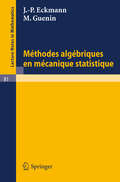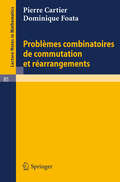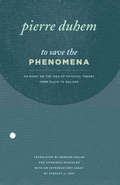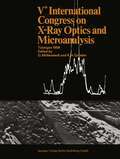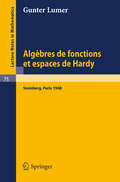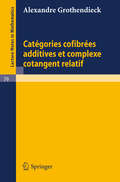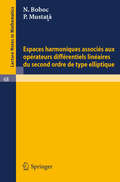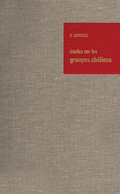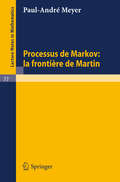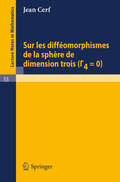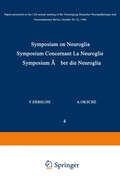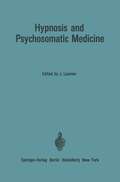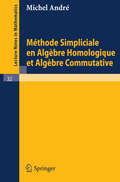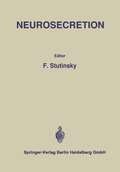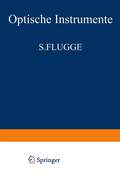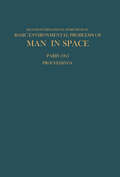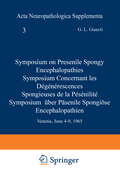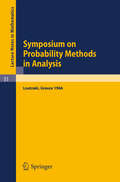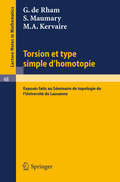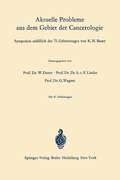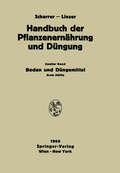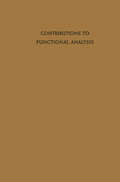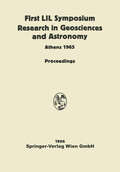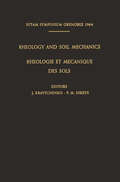- Table View
- List View
Methodes Algebriques en Mecanique Statistique (Lecture Notes in Mathematics #81)
by J.-P. Eckmann M. GueninProblemes combinatoires de commutation et rearrangements (Lecture Notes in Mathematics #85)
by Pierre Cartier Dominique FoataTo Save the Phenomena: An Essay on the Idea of Physical Theory from Plato to Galileo
by Pierre DuhemDuhem's 1908 essay questions the relation between physical theory and metaphysics and, more specifically, between astronomy and physics–an issue still of importance today. He critiques the answers given by Greek thought, Arabic science, medieval Christian scholasticism, and, finally, the astronomers of the Renaissance.
To Save the Phenomena: An Essay on the Idea of Physical Theory from Plato to Galileo
by Pierre DuhemDuhem's 1908 essay questions the relation between physical theory and metaphysics and, more specifically, between astronomy and physics–an issue still of importance today. He critiques the answers given by Greek thought, Arabic science, medieval Christian scholasticism, and, finally, the astronomers of the Renaissance.
Vth International Congress on X-Ray Optics and Microanalysis / V. Internationaler Kongreß für Röntgenoptik und Mikroanalyse / Ve Congrès International sur l’Optique des Rayons X et la Microanalyse: Tübingen, September 9th–14th, 1968
by Gottfried Möllenstedt K. H. GauklerThe Fifth International Congress on X-Ray Optics and Microanalysis was organized by the Institute of Applied Physics at Tübingen University in Western Germany from September 9th through 14th, 1968. Since 1956, when the First Conference was arranged in Cambridge, England by one of the pioneers in this field, V. E. CossLETT, the experts in the fields of X-Ray Optics and Microanalysis have met every third year to exchange their scientific experiences. Later meetings were held at Uppsala, Sweden in 1959, at Stanford, California in 1962, and at Orsay, Francein 1965. The participants in the 1968 Conference came from the following countries: Germany 140, France 60, Great Britain 55, USA 20, Netherlands 16, Switzerland 12, Austria 9, Sweden 7, Belgium 6, Japan 5, Italy 4, two each from Israel, Yugoslavia, Canada, Norway, Hungary and one each from Argentine, Poland, South Africa. As at the latest congress in Paris the following central topics were treated: General problems of X-ray optics, physical bases of electron beam microanalysis, quantitative problems of X-ray microanalysis, instrumentation, microdiffraction, applications to metal lurgy, mineralogy, and biology. An exhibition showing some of the most modern instruments formed an important part of the conference. The Springer-Verlag, Heidelberg, deserves thanks for the careful and speedy work they have performed in printing these conference proceedings. We are further indebted to all contributors of this volume for their kind cooperation. Tübingen, August 1969 G. MöLLENSTEDT and K. H.
Categories Confibrees Additives et Complexe Cotangent Relatif (Lecture Notes in Mathematics #79)
by Alexandre GrothendieckEspaces harmoniques associes aux operateurs differentiels lineaires du second ordre de type elliptique (Lecture Notes in Mathematics #68)
by N. Boboc P. MustataÉtudes sur les Groupes Abéliens / Studies on Abelian Groups: Colloque sur la Théorie des Groupes abéliens tenu à l’Université de Montpellier en juin 1967
by Bernard CharlesSur les diffeomorphismes de la sphere de dimensions trois (Lecture Notes in Mathematics #53)
by Jean CerfSymposium on Neuroglia / Symposium Concernant La Neuroglie / Symposium über die Neuroglia: Papers Presented on the 12th Annual Meeting of the Vereinigung Deutscher Neuropathologen und Neuroanatomen Berlin, October 20–22, 1966 (Acta Neuropathologica Supplementa #4)
by F. Erbslöh A. Oksche F. SeitelbergerHypnosis and Psychosomatic Medicine: Proceedings of the International Congress for Hypnosis and Psychosomatic Medicine / Mémoires du Congrès International d’Hypnose et de Médecine Psychosomatique / Beiträge zum Internationalen Kongreß für Hypnose und Psychosomatische Medizin
by Jean LassnerMethode Simpliciale en Algebre Homologigue et Algebre Commutative (Lecture Notes in Mathematics #32)
by Michel AndreNeurosecretion: IV. International Symposium on Neurosecretion / IVe Symposium International sur la Neurosécrétion
by F. StutinskyOptische Instrumente / Optical Instruments (Handbuch der Physik Encyclopedia of Physics #5 / 29)
by S. FlüggeProceedings of the Second International Symposium on Basic Environmental Problems of Man in Space: Paris, 14–18 June 1965
by Hilding BjurstedtOrganized by the International Astronautical Federation and the International Academy of Astronautics with the Support and Cooperation of UNESCO, the International Atomic Energy Agency, the WHO, the World Meteorological Organization, andthe International Telecommunication Union
Symposium on Presenile Spongy Encephalopathies / Symposium Concernant les Dégénérescences Spongieuses de la Présénilité / Symposium Über Präsenile Spongiöse Encephalopathien: Venetia, June 4–9, 1965 (Acta Neuropathologica Supplementa #3)
by G. L. Guazzi F. SeitelbergerSymposium on Probability Methods in Analysis: Lectures Delivered at a Symposium at Loutraki, Greece, 22.5. - 4.6.66 (Lecture Notes in Mathematics #31)
by Jean-Michel Morel Bernard TeissierTorsion et Type Simple d'Homotopie: Exposes faits au Seminaire de Topologie de l`Universite de Lausanne (Lecture Notes in Mathematics #48)
by G. de Rham S. Maumary M.A. KervaireAktuelle Probleme aus dem Gebiet der Cancerologie: Symposion anläßlich des 75. Geburtstages von K. H. Bauer
by W. Doerr F. Linder W. WagnerBoden und Düngemittel (Handbuch der Pflanzenernährung und Düngung #2 / 2)
by E. Abrahamczik J. M. Herrera H.-J. Altemüller A. Amberger N. Atanasiu J. Baeyens H. Banthien G. Barbier P. Boekel H. Bortels G. Braune M. F. Boodt L. De Leenheer E. Eriksson W. Flaig H. Franz H. Frese A. Fruhstorfer S. Gericke Gertraude Glathe H. Glathe W. Höfner K. Kaindl E. Knickmann H. Koepf J. J. Lehr H. Linser H. Löcker E. Mückenhausen H. Müller D. J. Nicholas T. Niedermaier P. K. Peerlkamp V. Rank K. Rauhe E. Rauterberg G. Riehle J. Chr. Salfeld H. K. Schäfer K. C. Scheel U. Schwertmann H. Söchtig S. Trocmé B. Wohlrab F.-H. ZiemerContributions to Functional Analysis
by Harro Heuser R. E. Fullerton C. C. Braunschweiger Ebbe Thue Poulsen Jean Leray Gregers Krabbe Anastasios Mallios Tosio Kato Felix E. Browder Takako Kōmura Yukio Kōmura Helmut H. Schaefer Kosaku Yosida Nelson Dunford Joseph Nieto W. A. Luxemburg A. C. Zaanen J. L. Cooper R. S. Bucy G. Maltese Jean Dieudonné H. G. Garnir Heinz König Angus E. Taylor Max Landsberg Thomas Riedrich E. Michael A. Martineau J. L. Kelley Vlastimil Pták Shozo Koshi Horst Leptin H. Reiter L. Waelbroeck N. Aronszajn P. Szeptycki Richard Arens Czeslaw Bessaga Victor Klee Hidegoro Nakano Joseph Wloka Ky Fan Hubert Berens P. L. Butzer H. O. Cordes Stefan Hildebrandt Gerhard Neubauer J. B. Diaz F. T. Metcalf Günter Ewald M. A. Naǐmark Elmar Thoma Bernhard GramschProceedings of the First Lunar International Laboratory (LIL) Symposium Research in Geosciences and Astronomy: Organized by the International Academy of Astronautics at the XVIth International Astronautical Congress Athens, 16 September, 1965 and Dedicated to the Twentieth Anniversary of UNESCO
by Frank J. MalinaThe Lunar International Laboratory (LIL) project of the International Academy of Astronautics was begun upon the proposal of the editor at the First Special Meeting of the Academy at Stockholm on 16 August 1960. The late THEODORE VON KARMAN, first President of the Academy, appointed the following members of the LIL Committee: Prof. N. BoNEFF (Bulgaria), Prof. M. FLoRKIN (Belgium), Mr. A. G. HALEY (U. S. A. ), Prof. Sir BERNARD LovELL (U. K. ) (Vice Chairman), Prof. L. MALAVARD (France), Dr. F. J. MALINA (U. S. A. ) (Chairman), Prof. H. 0BERTH (German Federal Republic), Dr. W. H. PicKERING (U. S. A. ), Prof. E. SANGER (German Federal Republic), Prof. L. I. SEDOV (U. S. S. R. ), Prof. L. SPITZER, JR. (U. S. A. ), Dr. H. STRUGHOLD (U. S. A. ), Prof. H. C. UREY (U. S. A. ) and himself. Since 1960 the following additional members were appointed to the Committee: Mr. A. C. CLARKE (U. K. ), Prof. A. DoLLFUS (France), Prof. Z. KoPAL (U. K. ), Dr. S. F. SINGER (U. S. A. ), Prof. N. M. SISSAKIAN (U. S. S. R. ) and Prof. F. ZWICKY (Switzerland). The Academy authorized the Committee to study the technical problems related to the construction of a manned research laboratory on the Moon and the feasibility of carrying out its construction, and to consider the fields of research which would initially be undertaken.
Rheology and Soil Mechanics / Rhéologie et Mécanique des Sols: Symposium Grenoble, April 1–8, 1964 / Symposium Grenoble, 1Er–8 Avril 1964 (IUTAM Symposia)
by J. Kravtchenko P. M. SirieysFor a long period Soil Mechanics has remained at the semi-empirica stage, and only a few decades ago it has shown a tendency to become a fundamental science. However, this evolution is taking place slowly; in spite of the efforts of numerous research scientists, the very complex rheological laws of soils are still not well known. Even if these laws were elucidated, it would take a long time still to deduce simple rules from them for reliable and convenient use in current practical engineer ing. In the pursuit of these distant aims - and of others more imme diate - fundamental research and applied research are very active, both in Rheology and Soil Mechanics. The complexity of the problems to be solved should incite the laboratory researchers and the engineers to a continuous collaboration. Everyone acknowledges the advantage of these connections although aware of the difficulty of realizing this wish. However, contacts are being made little by little between the repre sentatives of the different branches of Rheology and Soil Mechanics, to the great benefit of science. The bureau of the International Union of Theoretical and Applied Mechanics (IUTAM), aware of the importance of these two associat ed fields of mechanics, considered it possible to accelerate the natural and necessary processus of their interpenetration by organizing in Grenoble, from 1st to 8th April 1964 an International Symposium on Rheology and Soil Mechanics.
